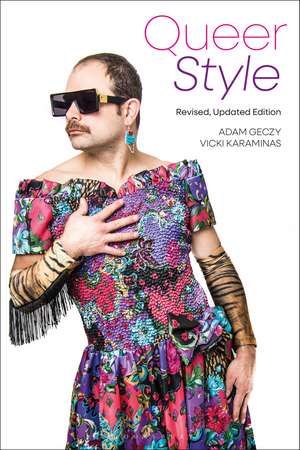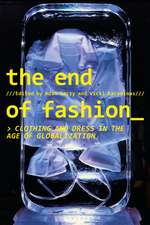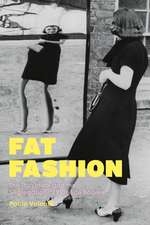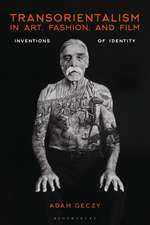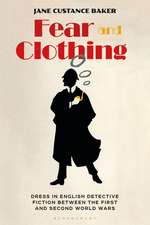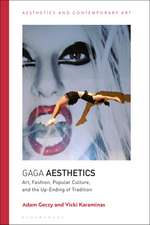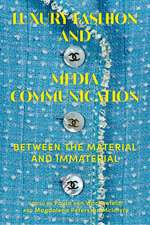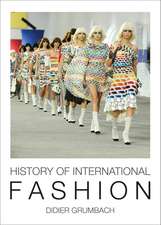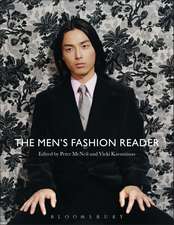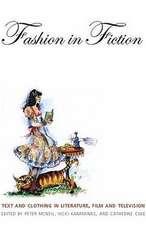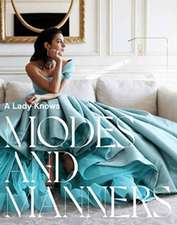Queer Style: Revised and Updated Edition
Autor Adam Geczy, Vicki Karaminasen Limba Engleză Paperback – 12 iun 2024
| Toate formatele și edițiile | Preț | Express |
|---|---|---|
| Paperback (1) | 173.73 lei 3-5 săpt. | +56.00 lei 7-13 zile |
| Bloomsbury Publishing – 12 iun 2024 | 173.73 lei 3-5 săpt. | +56.00 lei 7-13 zile |
| Hardback (2) | 473.98 lei 3-5 săpt. | |
| Bloomsbury Publishing – 12 iun 2024 | 473.98 lei 3-5 săpt. | |
| Bloomsbury Publishing – 14 aug 2013 | 763.93 lei 6-8 săpt. |
Preț: 173.73 lei
Preț vechi: 197.25 lei
-12% Nou
Puncte Express: 261
Preț estimativ în valută:
33.25€ • 34.45$ • 27.75£
33.25€ • 34.45$ • 27.75£
Carte disponibilă
Livrare economică 28 februarie-14 martie
Livrare express 14-20 februarie pentru 65.99 lei
Preluare comenzi: 021 569.72.76
Specificații
ISBN-13: 9781350365926
ISBN-10: 1350365920
Pagini: 320
Ilustrații: 81 bw illus
Dimensiuni: 156 x 234 x 25 mm
Greutate: 0.74 kg
Ediția:2Revizuită
Editura: Bloomsbury Publishing
Colecția Bloomsbury Visual Arts
Locul publicării:London, United Kingdom
ISBN-10: 1350365920
Pagini: 320
Ilustrații: 81 bw illus
Dimensiuni: 156 x 234 x 25 mm
Greutate: 0.74 kg
Ediția:2Revizuită
Editura: Bloomsbury Publishing
Colecția Bloomsbury Visual Arts
Locul publicării:London, United Kingdom
Caracteristici
Updated terminology throughout (incorporating contemporary use of new terms and pronouns so "Trans", GNC and "CIS" gender).
Notă biografică
Adam Geczy is an artist and writer who teaches at the University of Sydney, Australia.Vicki Karaminas is Professor of Fashion and Director of Doctoral Studies for the School of Design at the College of Creative Arts, Massey University, Wellington, New Zealand.
Cuprins
List of IllustrationsAcknowledgementsIntroduction1. The Meaning of Style Between Classic and QueerWinckelmann and the Suppressed Homoerotism in Modernist styleA Selective History of Non-queer, Standard, Straight and Classic dressing2.. Lesbian Style: From Mannish Women to Lipstick DykesMannish Lesbians and Salon DandiesLesbian Bar Culture of the Forties and FiftiesFeminist Androgyny and Anti StyleCross Dressing and Androgynous StyleDesigner Dykes and Lesbian ChicLesbian Visibility in the Twentieth Century3. Designer Dykes and Lesbian Visibility The L Word and Generation QLesbian Chic The Pleasures of Looking. Lesbians in film and media Hip Hop Lesbian Style4. Early Modern Gay Men's StylesMacaroni's and FopsDandies and Aesthetes. The Early Days of Queer StyleWilde, Posing, and the 'Birth' of HomosexualityParis Dandies, Aesthetes and Decadents5. Modern and Contemporary Gay Men's Styles The Years Pending World War IIArtistic Bent. Warhol, Glam and PopGay Activism and Gay prideContemporary Queer: Hard to Say6. Kiss of the Whip. Bondage, Discipline and Sado-Masochism, or BDSM StyleMilitary Uniforms and the GestapoClips, Clamps Leather, and AccessoriesThe Mainstreaming of BDSM7. Drag Kings and QueensDames and QueensDrag and Artistic PracticeDrag as Politics Drag BallsKinging and Club CultureRuPaul Supermodel8. Trans* and Fluid StyleBy Way of a GeneologyAgainst CategorizationTransgender CelebrityFluid Fashion and Style9. Crossing Genders, Crossing CulturesJapanese Dandy StyleAlbanian Sworn VirginsThe Hijra: An Alternative Gender Role in IndiaFa'fafine and Polynesian Gender CrossingTwo Spirit First NationKathoey and Tom Boys of ThailandConclusion: Against JustificationBibliographyIndex
Recenzii
If clothes make the man (and the woman), how much more do they make the queer man or woman. This insightful book looks at the way fashion has coded same-sex desire, from eighteenth-century macaronis and gentlemen fops to modern leathermen and muscle queens, from mannish Sapphic women to lipstick lesbians. As those with homoerotic orientations constructed their sexualities and identities, the authors reveal, so they dressed themselves for the parts they played.
From Rosa Bonheur and Radclyffe Hall through Bowie and Warhol to Boy George and Leigh Bowery: just a few of the style icons present in this wide-ranging, illuminating and highly readable account of over two centuries of queer performance and posing.
This book provides a refreshingly engaging and extraordinarily superior standard ofscholarship that inquires analytically into complex LGBTQI issues and challenges &complements the works of Bultler, Foucault, Halberstam, Shapiro and others in the field.Their work will contribute to original scholarship on LGBTQI in a number of related ways.This text further gives voice to the many LGBTQI communities of actors and displays ascholarly trajectory that is not only well-grounded but combines the best traditions oftheoretical and methodological triangulation.
This book is impressive in rigor, scope and scholarship. It assembles iconic stylish and fashionable gay, lesbian, transgendered and queer characters such as: dandies and dykes, leather-boys and lipstick lesbians. While, there has been a tremendous amount of writing in queer studies, none has combined it with fashion and style to give us a fresh look at fashion studies. With panache and humor, this much-anticipated text is the first extensive analysis of both fashion scholarship and queer theory - it undoubtedly is destined to become a classic.
Much of what counts as queer theory now, and in recent years, has danced around the question of style. Is style the name for a self-fashioning that marks the emergence of self-consciously gay and lesbian populations around the beginning of the twentieth century? Or is style a recognizable form of gay, lesbian and transgender narrative, readable on bodies and texts alike? Is style a mode of being and becoming that both disrupts chronological histories of sexuality and confirms them all at once? The answer given by this fresh, new volume on the subject is yes, yes, and yes. As to whether you can wear white shoes after summer's end, blue and green together or a meat dress to the Oscars.you are on your own.
This is an extremely important book. The subject of GLBTQ fashion and style has been sadly neglected and this book marks a clear redresseing of that neglect. Queer Style is a well researched and eloquently written book that fills a massive gap in the current writing on this important area of fashion, dress and identity. The subject matter covered in this book is a much neglected area of study and Geczy and Karaminas's complementary backgrounds and areas of interest provide a much needed and long overdue articulate contribution to the area. The depth of research as well the global aspects of the book make this an invaluable text for accomplished scholars and to students from a range of academic courses. I thoroughly recommend this book.
From Rosa Bonheur and Radclyffe Hall through Bowie and Warhol to Boy George and Leigh Bowery: just a few of the style icons present in this wide-ranging, illuminating and highly readable account of over two centuries of queer performance and posing.
This book provides a refreshingly engaging and extraordinarily superior standard ofscholarship that inquires analytically into complex LGBTQI issues and challenges &complements the works of Bultler, Foucault, Halberstam, Shapiro and others in the field.Their work will contribute to original scholarship on LGBTQI in a number of related ways.This text further gives voice to the many LGBTQI communities of actors and displays ascholarly trajectory that is not only well-grounded but combines the best traditions oftheoretical and methodological triangulation.
This book is impressive in rigor, scope and scholarship. It assembles iconic stylish and fashionable gay, lesbian, transgendered and queer characters such as: dandies and dykes, leather-boys and lipstick lesbians. While, there has been a tremendous amount of writing in queer studies, none has combined it with fashion and style to give us a fresh look at fashion studies. With panache and humor, this much-anticipated text is the first extensive analysis of both fashion scholarship and queer theory - it undoubtedly is destined to become a classic.
Much of what counts as queer theory now, and in recent years, has danced around the question of style. Is style the name for a self-fashioning that marks the emergence of self-consciously gay and lesbian populations around the beginning of the twentieth century? Or is style a recognizable form of gay, lesbian and transgender narrative, readable on bodies and texts alike? Is style a mode of being and becoming that both disrupts chronological histories of sexuality and confirms them all at once? The answer given by this fresh, new volume on the subject is yes, yes, and yes. As to whether you can wear white shoes after summer's end, blue and green together or a meat dress to the Oscars.you are on your own.
This is an extremely important book. The subject of GLBTQ fashion and style has been sadly neglected and this book marks a clear redresseing of that neglect. Queer Style is a well researched and eloquently written book that fills a massive gap in the current writing on this important area of fashion, dress and identity. The subject matter covered in this book is a much neglected area of study and Geczy and Karaminas's complementary backgrounds and areas of interest provide a much needed and long overdue articulate contribution to the area. The depth of research as well the global aspects of the book make this an invaluable text for accomplished scholars and to students from a range of academic courses. I thoroughly recommend this book.
Descriere
Descriere de la o altă ediție sau format:
Offers an account of queer fashionability in historical as well as contemporary lifestyles.
Offers an account of queer fashionability in historical as well as contemporary lifestyles.
